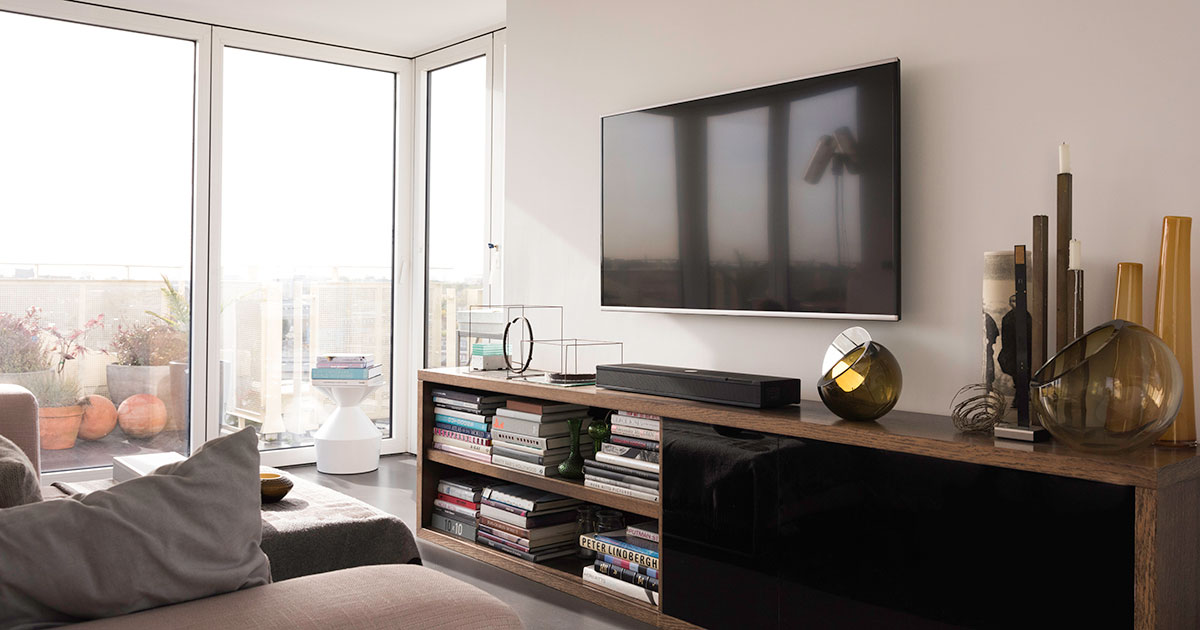Loud soundbars: how to spot a quality in-built subwoofer
There’s an irony about modern television: as video quality has improved, sound quality has worsened. Read on to find how soundbars can enhance audio experiences.
The latest generation of flat screen TVs produce an amazing picture, but their tiny underpowered speakers leave plenty to be desired in terms of sound clarity. So naturally, cinema and sound enthusiasts have looked for alternative speakers to beef up their TV’s tinny audio. Enter the soundbar.
Soundbars 101
Soundbars, which contain various speakers in one long bar, have become increasingly popular over the last few years; mainly because they are one of the easiest ways to 'fix' the problem of flat screen TV sound quality. Far more straightforward than wiring together a full surround system, they're also an efficient means of decluttering your living room and save on space. No bulky AV receivers required. If you've invested in a quality TV, it probably goes without saying that you shouldn't sell your entertainment experience short with subpar sound.
And not just from your TV; wireless enabled soundbars allow you to stream audio from various other devices devices without a cable in sight. Soundbars usually don't boast the level of musical quality that a dedicated stereo powered speaker system does; however, since they’re designed specifically for TV usage, this is to be expected. A good soundbar should satisfy all but the most hardcore audiophile.
All about that bass
One of the keys to a good soundbar that delivers is a quality subwoofer. The subwoofer produces sound at the low end of the audio spectrum, typically around 20 - 200 Hz in home systems. This is sound that you can barely hear, but that you can feel. Strange as it may seem, it’s integral to powerful audio.
There's a common misconception that you 'only' need a good sub for particularly bass heavy genres of music, or action movies. This isn’t entirely true - though your sub will help you to appreciate action movie explosions and rumbling bass guitars. The truth is most recordings do encompass the subwoofer frequency range; you could say that a subwoofer enhances whatever you listen to. It provides something you can’t quite grasp but you know it when you feel it.
The good news is that it is possible to get an excellent bass sound without the hassle of a separate subwoofer. Various soundbars have built-in subwoofers. These are sometimes known as 'soundbases', 'speakerbases' or 'standalone soundbars'. They are usually larger than regular soundbars, and, due to their size and weight, they often sit beneath your TV.
To keep things simple, we’ll refer to soundbars with built-in subwoofers as soundbases going forward.
Why choose a built in subwoofer? The main reason is convenience; soundbases take the 'plug and play' aspect of a soundbar even further. It removes the need to even set up a separate sub. Generally, the sound quality is better too. The soundbase's larger frame means larger and more powerful speakers to go with the inbuilt sub.
So what are the reasons against choosing a soundbase? Short answer: less choice. There are far less soundbases on the market than there are soundbars. They're also less flexible when it comes to placement - usually too heavy to mount on a wall. The dimensions have to be right too, in that they’re wide enough to support your TV if you're mounting it underneath.
Jargon explained
Of course, the idea behind the soundbar/soundbase is straightforward enough, but the jargon used in the description of these products can be perplexing.
One thing that seems to cause confusion is the number system used in audio devices, such as '3.1.4'.
It's actually not too difficult - the first number refers to how many drivers a soundbar has. So '3' would be a three channel soundbar - left, right, and centre. Similarly, '2' would indicate a two channel soundbar - left and right.
The second number indicates whether the soundbar has a subwoofer or not - '1' for yes, '0' for no.
The third number is used to refer to the number of speakers that fire at the ceiling, bouncing the sound around the room to create a surround effect. So '3.1.4' would indicate a system with three channels, a sub, and surround sound capability.
If you're considering a soundbase, there are a few things for you to look out for.

How to spot a quality built-in subwoofer
As with any product, few things can help you make a better buying decision than trying it for yourself. If you can, ask for a demo of your potential soundbase with your favourite movie or some songs that you really enjoy. Make sure you pick a particularly bass heavy track or scene to really put the soundbase through its paces. Try some dialogue too if you're a film watcher, you'll find some soundbases reproduce dialogue more clearly than others.
Check subwoofer sizes
Generally, subwoofers come in a range of sizes between 8 -15 inches. As you might expect, and as a general rule, larger subwoofers provide deeper and louder bass. Larger rooms require larger bass drivers; 8 inches should suit a small room, but if you're wiring up a large room, you may be looking at 10 inches or larger. There's a reason why subwoofers for big music venues are often so large.
Check the power / wattage
Along with sub sizes, wattage is a good way to determine how powerful a sub really is. Like many things in life, bigger is not always better. Many home subwoofers are rated between 100 -150 watts of power, which usually suits a small to average sized room. Larger subwoofers - which can work for larger rooms - can go up to 250 watts or greater. That said, it’s generally acknowledged that anything above 250 watts may be a little excessive.
Check the subwoofer directions
Speaking of excessive, sounds at deep bass frequencies can be described as 'non-directional'; we can't perceive the direction they're coming from.
For this reason, some speaker setups have downward or upward firing subwoofers, which bounce sound around the room. If you live with neighbours above, below or beside you, you'll want to bear in mind that as well as bouncing the sound around your space, it will also project some of that sound it into your neighbour's space too.
Consider connection options and HDMI.
As a rule, most modern soundbars are HDMI compatible but the more connection options your soundbase has, the more options you have. As a format, HDMI is preferable. It supports 4k video and higher audio quality than the older optical/toslink connection formats which also require more cables than a single HDMI.
If you don't want too many remote controls in your life make sure your soundbase has an IR pass through feature, or can 'learn' from your TV remote. A HDMI port that’s Audio Return Channel (ARC) compatible should allow you to control your soundbase with your TV remote.
Surround sound
One feature that any avid movie lover should consider is surround sound. Whilst technically not 'true' surround (due to the fact that the speakers are all located in a single spot) many soundbases have simulated surround sound that is pretty convincing - and without the hassle of having to install surround speakers in the right places around your room.
Hopefully that’s given you some direction when choosing a quality soundbar for that cinema experience. If you’re interested in checking out our own soundbars, you can have a look at our new P70W. We’re confident it’ll give you the kind of sound clarity you’re looking for; honestly, we’re quite excited to show it off.





